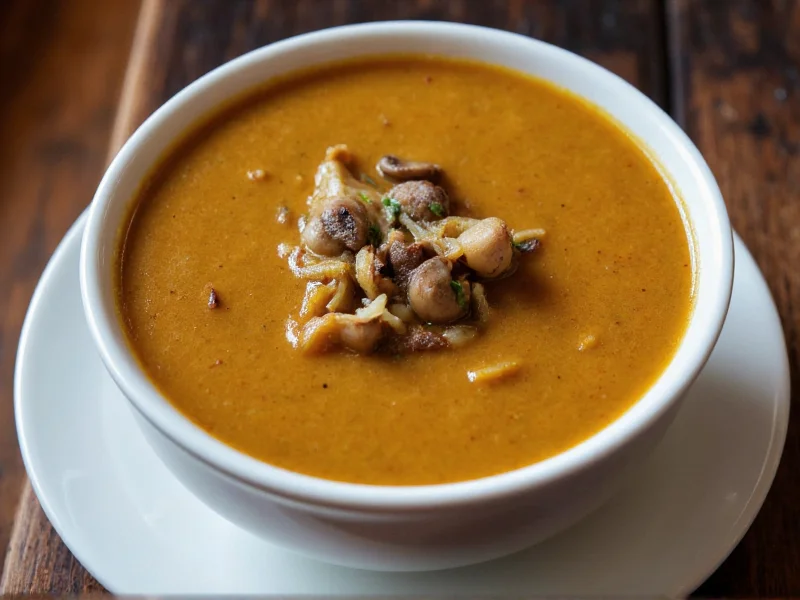The Science Behind Perfect Mushroom Soup
Mushroom soup seems simple, but achieving that rich, complex flavor requires understanding the science behind it. When mushrooms cook, they release water through evaporation, concentrating their natural glutamates that create umami depth. This process, called the Maillard reaction, transforms ordinary mushrooms into flavor powerhouses.
Professional chefs know that cooking mushrooms in batches prevents steaming and ensures proper browning. Overcrowding the pan lowers the temperature, causing mushrooms to release water instead of developing that essential caramelized crust. For the most flavorful mushroom soup from scratch, dedicate 10-15 minutes just to properly cooking your mushrooms.
Essential Ingredients and Their Roles
The magic of mushroom soup comes from carefully selected ingredients working in harmony:
| Ingredient | Function | Best Varieties |
|---|---|---|
| Mushrooms | Primary flavor base | Cremini, shiitake, porcini (dried) |
| Aromatics | Flavor foundation | Yellow onion, leek, shallot |
| Liquid | Carries and distributes flavor | Homemade stock, quality broth |
| Thickener | Creates proper texture | Roux, pureed mushrooms, potato |
| Acid | Balances richness | Lemon juice, sherry vinegar |
Step-by-Step Preparation Guide
Follow these professional techniques for restaurant-quality mushroom soup at home:
- Prepare ingredients properly - Clean mushrooms with a damp cloth (never soak), slice uniformly, and keep aromatics separate
- Sauté mushrooms in batches - Use high heat with neutral oil, cook until deeply browned (10-15 minutes)
- Build flavor foundation - Cook onions until translucent, add garlic and thyme, then deglaze with sherry
- Create roux (optional) - For creamy mushroom soup without cream, cook equal parts butter and flour for 2 minutes
- Combine and simmer - Add stock gradually, return mushrooms, simmer 15-20 minutes
- Final seasoning - Add acid (lemon juice), fresh herbs, and adjust salt at the end
Avoiding Common Mushroom Soup Mistakes
Even experienced cooks make these critical errors when preparing mushroom soup:
- Using only button mushrooms - While affordable, white button mushrooms lack the depth of cremini or shiitake. For best results, use a blend of 3-4 mushroom varieties
- Adding liquid too soon - Wait until mushrooms are properly browned before adding any liquid to preserve flavor development
- Over-blending - When making creamy mushroom soup, blend only half the soup for ideal texture with mushroom pieces
- Skipping the acid - A touch of lemon juice or vinegar balances richness and brightens flavors
- Using low-quality broth - The liquid makes up 70% of your soup; homemade or premium store-bought broth is essential
Healthy Mushroom Soup Variations
Adapt this versatile recipe for different dietary needs while maintaining rich flavor:
Vegan Mushroom Soup
Replace dairy with cashew cream or coconut milk. For umami depth, add 1 teaspoon soy sauce or 2 rehydrated dried porcini mushrooms. Sauté mushrooms in olive oil instead of butter.
Gluten-Free Mushroom Soup
Skip the roux and thicken with pureed mushrooms or a small diced potato simmered with the soup. Arrowroot powder (1 tablespoon mixed with 2 tablespoons cold water) makes an excellent gluten-free thickener added at the end.
Low-Sodium Mushroom Soup
Use homemade mushroom stock or low-sodium broth. Boost flavor with extra mushrooms, fresh herbs, and a splash of balsamic vinegar instead of salt. Roast mushrooms first to intensify natural flavors.
Storage and Reheating Tips
Proper storage maintains quality and safety of your homemade mushroom soup:
- Refrigeration - Store in airtight container for up to 4 days. The soup often tastes better the next day as flavors meld
- Freezing - Freeze without dairy for best results (add cream when reheating). Portion in freezer bags flat for quick thawing
- Reheating - Warm gently over medium-low heat. If using dairy, add it after soup is hot to prevent curdling
- Reviving - Add a splash of fresh broth if soup thickens too much during storage. Finish with fresh herbs and acid
Nutritional Benefits of Mushroom Soup
Mushroom soup offers surprising health benefits beyond its comforting flavor:
Mushrooms are one of the few natural food sources of vitamin D, especially when exposed to sunlight. They contain beta-glucans that support immune function and selenium for antioxidant protection. When prepared properly, mushroom soup without cream remains low in calories while providing satisfying umami flavor.
For maximum nutritional value, use a variety of mushrooms as different species offer unique phytonutrients. Shiitake mushrooms contain lentinan, which has been studied for immune support, while cremini mushrooms provide more potassium than button mushrooms.











 浙公网安备
33010002000092号
浙公网安备
33010002000092号 浙B2-20120091-4
浙B2-20120091-4